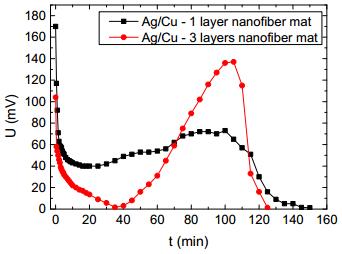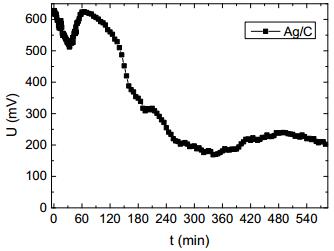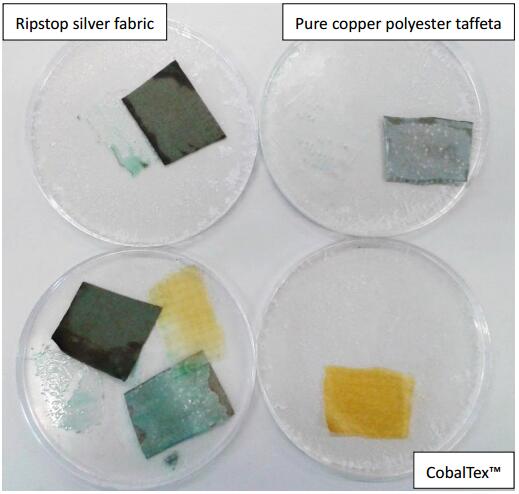1. Introduction
During the last years, an emerging interest in smart textiles could be observed. Most of these "smart" or "intelligent" textiles are electronic textiles, i.e. they contain electronic components which necessitate an energy source.
Typical energy sources are batteries, capacitors or pseudo-capacitors. In common rigid versions, such power supplies disturb the typical textile haptics as well as drape and bendability. This is why purely textile batteries are of high interest in the field of smart textiles and investigated by different research groups [1]. Often textile batteries, capacitors or pseudo-capacitors are developed in the shape of fibers which can be integrated into a woven or knitted fabric afterwards [2,3,4]. On the other hand, layered systems produced by coating textile fabrics are also interesting due to their larger areas [5].
Different material combinations were investigated recently. Silver electrodes combined with PEDOT as electrolyte was found to be usable for rechargeable batteries [6]. Carbon nanotubes were also successfully tested as electrode material [7]. On the other hand, materials similar to those used in common batteries were investigated, such as lithium-iron-phosphate and lithium titanate [4]. Combining lithium ion technology with textile fabrics resulted in flexible batteries with high working potentials and good storage performance, especially for textile fabrics with large surfaces due to additional pores, nanoparticles, nanowires, etc. [8,9,10].
Principally, a battery consists of two (or more) electrodes prepared from different materials which are separated by an electrolyte. According to the Nernst equation, the maximum possible voltage between them depends on the difference between their redox potentials, modified by secondary effects, such as over-potentials. In the electrolyte, different partial reactions occur near both electrodes, triggering this redox reaction. When a circuit is closed along an external load, a current can flow. This means that, as a first idea, both electrode materials should have significantly differing standard potentials. Typical values are, e.g., E0, Cu = 0.34 V for copper and E0, Ag = 0.79 V for silver [11,12]. Several other metals with significantly higher standard potentials are not useful for integration in textile fabrics due to their toxicity or possible allergic reactions.
As earlier investigations have shown, carbon—which is not included in the standard potential series and does not take place in the redox reaction, but works as a pick-up electrode for redox reactions in the electrolyte itself [13]—is also an interesting electrode material. In this combination, the standard potential of the electrolyte is described as 0.35 V in the literature [14].
Different combinations of these electrodes were tested using metal salts [15] or iodine-triiodide as electrolytes [16], the latter having shown to be advantageous. The electrolyte was either gelled [15,16] or dropped onto a textile fabric which contained both electrodes, applied by Tailored Fiber Placement [17]. In both cases, the electrolyte suffers from immediate drying. This is why in a recent project, nanofiber mats were used to embed the electrolyte and to test the longevity of such battery systems, while all-solid state textile batteries [18] have not been taken into account here.
2. Materials and methods
For the batteries under investigation here, ripstop silver fabric, pure copper polyester taffeta and CobalTex™ (all purchased from Less EMF Inc.) were used as well as a carbon woven fabric (HP-Textiles). All battery areas were 4 cm x 4 cm, with additional small parts protruding from the battery composite at opposite ends to allow for connecting both electrodes separately with crocodile clips. The metal-coated fabrics have areal weights of approx. 80 g/m2, similar to a sheet of paper, and a thickness of 0.06-0.08 mm, and are thus very flexible and lightweight. Since they are woven, they are not stretchable, but can be imagined to be worn as a part of a jacket. Photographs of such fabrics can be found, e.g., in Refs. 15 and 16.
As an electrolyte, Lugol's solution (5%) was used (AppliChem). This electrolyte was embedded in a polyacrylonitrile (PAN) nanofiber mat, electrospun using a Nanospider Lab. The production process is described in detail in [19]. The nanofibers in such mats have diameters of approx. 300-500 nm and are fixed in a dense mat, without single nanofibers protruding from the base material. Areal weights are typically about 0.5-3 g/m2.
The batteries were built by soaking the nanofiber mat into the electrolyte, placing it on top of the bottom electrode, adding drops of electrolyte carefully where the system seemed to be dryer than on average and placing the second electrode on top. The crocodile clips connected to the electrodes were fixed in positions where they did not exert any visible force onto the electrodes to avoid undesired squeezing or pulling. The excess electrolyte around the bottom electrode was carefully removed using a cotton bud to avoid creating an undesired reservoir of electrolyte outside the battery.
Measurements were taken using two multimeters and a resistance decade set to 100 kΩ to allow for slow discharging of the textile batteries, enabling better visibility of aging effects which are not related to discharge but to degradation or drying of the involved materials. The relatively small currents showed relatively large standard deviations and systematic errors due to the large inner resistances of the multimeters and are thus not depicted here. For the voltage measurements, no such systematic errors are expected, and the relatively small variations of the values on the timescale of seconds did not significantly influence the results.
3. Results and discussion
Figure 1 depicts time-dependent voltages, measured during discharge of two textile metal-metal batteries over a resistance of 100 kΩ. Both consist of silver and copper electrodes with iodine-triiodide as an electrolyte, stored in 1 or 3 layers of a PAN nanofiber mat, respectively.
Firstly, it is visible that the maximally expected voltage of approx. 0.4 V is not reached. Second, both batteries are completely dried after 2-2.5 hours. This value is similar to the drying time of approx. 2 h in a previous investigation with a gelled electrolyte [15]. In both cases, a maximum occurs around 100 min which can be attributed to an increased inner resistance of the battery due to drying.
Since previous investigations found that metal-carbon batteries are superior to metal-metal ones, the next test was performed combining silver and carbon electrodes with one layer of electrolyte-soaked nanofiber mat. The time-dependence of such a battery is depicted in Figure 2.
Firstly, the maximum voltage is significantly higher than the values reached for silver-copper batteries. It should be mentioned that the maximum values of approx. 620 mV are also higher than those achieved by batteries prepared from the same materials with gelled (~520 mV) or liquid (dropped) electrolytes (~400 mV) [16,17] and also higher than the theoretical expectation, calculating the difference between the standard potentials of silver and iodine-triiodide [14]. The above given standard potential of silver of E0, Ag = 0.79 V, however, is calculated for the most common reaction of Ag+ + e− ⇌ Ag, while other reactions, e.g. Ag2O(s) + 2H+ + 2e− ⇌ 2Ag(s) + H2O, which may happen in aqueous solutions, have higher standard potentials above 1 V. This is a possible explanation for the unexpectedly high voltage achieved in this system. Apparently, the dynamics of chemical reactions taking place here differ from those usually assumed in theoretical models for both of these materials. At first glance, this finding makes this battery system look well-suited for integration in smart textiles.
The time-dependence, however, shows an interesting behavior. Similar to the metal-metal batteries, a local maximum in the voltage is visible after approx. 70 min, again indicating drying of the electrolyte. The dip in this system is visible later and shows a less strongly decreasing voltage than in the metal-metal batteries depicted in Figure 1, indicating that more electrolyte is stored in the thicker and coarser carbon woven fabric, than it is possible in the fine metal-coated fabrics. Afterwards, the voltage decreases to a relatively stable value around 200 mV. Investigation of the battery during this time shows that here, the carbon woven fabric—which is much more open-pored than typical metalized woven fabrics—serves as a refill reservoir for the electrolyte which is constantly transported to the nanofiber mat between both electrodes, keeping this interlayer always humid, but on a lower level than directly after soaking it with electrolyte. In this way, the battery does not completely dry for at least 10 hours. This effect can be assumed as a positive characteristic of the battery. On the other hand, an interesting aspect would be the calculation of the fluid dynamics of electrolytes in the different geometries given by the different woven fabrics, resulting in different resistances impeding the electrolyte flow and thus the exchange of electrolyte which has already been involved in a redox reaction.
While the principle idea of a secondary storage for an electrolyte may be taken into account, similar to the idea of refilling solar cells with electrolyte [20], other problems become visible by inspection of the solar cells after use. On the one hand, the silver electrode in all cases is destroyed, showing that here another limitation of the possible time of use has to be taken into account. On the other hand, the electrolyte shows a decoloration process which also implies a time limit for its use in solar-cell related applications, besides the drying process. Both problems were evaluated in more detail.
Interestingly, the time until the silver electrode was destroyed has changed from approx. 2 h for the metal-metal batteries to approx. one day for the silver-carbon battery. This finding underlines the above mentioned assumption that in metal-metal and metal-carbon electrodes with iodine/triiodide as electrolyte, different redox reactions may take place, as can be expected due to the different maximum voltages.
Figure 3 depicts the effect of leaving the metalized textile fabrics in iodine-triiodide solution for two days during which the electrolyte dried. It should be mentioned that CobalTex™ consists of nickel/copper/cobalt and can thus build a complete battery when inserted in the electrolyte. Thus it can be understood that for this material, the metal coating is completely destroyed. Both other materials (with copper and silver coatings), however, are apparently oxidized, but still existent. This is in contrast to the optical evaluation of the metal-metal batteries after complete drying of the electrolyte, as shown in Figure 4. After discharging such a battery, the silver coating is completely vanished, while the copper coating is only slightly oxidized.
This shows clearly that while the electrolyte does indeed damage the metal coatings, the visible complete vanishing of the silver electrode can be attributed to discharging the battery. Thus, the thickness of the silver coating also limits the maximum energy which can be gained from such a battery.
Additionally, the time-dependent behavior of pure iodine-triiodide was investigated by investigating the color of the electrolyte under different conditions (Figure 5): One solution was stored in an open glass at daylight ("air + light"), another one in an open glass in a dark box ("air, no light"), the third one in a closed (but not evacuated) glass at daylight ("no air, light"), and the last solution was soaked into a textile fabric ("textile"). As visible in Figure 5, avoiding air increases the longevity of the electrolyte strongest, while avoiding light decreases decoloration to a smaller amount. This finding is supported by a starch test using simple paper stripes (Figure 5, right panel): The darkest color is visible for the sample kept under air exclusion, followed by the sample stored in the dark. This shows clearly that iodine-triiodide can be photo-oxidized, a feature which is utilized, e.g., in dye-sensitized solar cells based on this electrolyte [14].
While avoiding sunlight, esp. UV irradiation, is a typical and not very problematic task for textile fabrics, completely avoiding air intrusion is nearly impossible without significantly altering the typical textile properties, especially the haptics and the water permeability which are both important factors for wearing comfort. This underlines that iodine-triiodide, although often used in textile batteries due to its non-toxicity, should be replaced by more stable alternatives.
The results shown here give an ambiguous impression of textile batteries with metal-carbon electrodes and iodine-triiodide as electrolyte embedded in a nanofiber fabric. On the one hand, sufficient voltages can be achieved which are higher than the maximum voltages reached in other systems with similar material combinations. On the other hand, the thin metal coatings on the textile fabrics are destroyed soon during discharging, and the electrolyte was clearly shown to be not long-time stable, impeding storage of such textile batteries for more than some days. Thus, both parts—electrolyte and thin metal layers—should be exchanged by more durable materials, e.g. using fine wires instead of metallic coatings.
4. Conclusion
Textile batteries produced from different metalized woven fabrics or a metal-coated textile and a carbon woven fabric were investigated, storing iodine-triiodide as an electrolyte in a nanofiber mat between the electrodes. While significantly higher voltages could be achieved than in previous experiments with identical materials and other methods to store the electrolyte, long-time tests show that the thin metal coatings are destroyed soon, while the electrolyte is photo-oxidized during few days, making such batteries only useful for instant use. Our results show that alternative electrolytes should be tested and combined with metal parts of different shapes, e.g. wires, while the principle idea of storing the electrolyte in a nanofiber mat is promising for future developments.
Conflict of interest
All authors declare no conflicts of interest in this paper.
Acknowledgements
The work was partially supported by the SUT Rector grant 14/990/RGJ18/0099 (T. B.).










 DownLoad:
DownLoad: 











